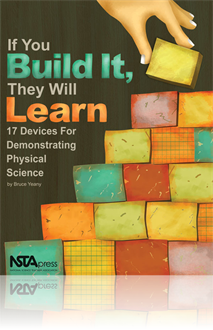All Book Chapters
Book Chapter
Hero of Alexandria, in about 62 AD, demonstrated that a small amount of water could be lifted to a point higher than its origin. This apparently contradicts that water can rise only to its own level. In this chapter, find out how a few soda bottles, ...
Book Chapter
String racers are an effective way to demonstrate Newton's third law. In this chapter, the instructions give plans for two types of string racers—the simple balloon racers that are quick and easy to build and a rubber band-powered propeller design ...
Book Chapter
The solar motor is an excellent way of demonstrating one method of changing solar energy directly into motion. For students to understand its operation, they need to understand some basic concepts. One is that matter can contract or expand due to tem...
Book Chapter
In this chapter, find out what a can of soda would feel like on other planets by altering the contents of several containers to simulate the change in surface gravity according to the various planets. This set of cans and a few other simple props can...
Book Chapter
This chapter provides the opportunity for students to observe the breakfast box sitting in plain view on a shelf, table, window ledge or in any other position that is remote enough to keep anyone from accidentally bumping against it. The box is unusu...
Book Chapter
A fossil is any evidence of an ancient organism. The remains of the body, such as bones, shells, leaf impressions, etc., are called body fossils. The evidence of animal activity, such as tracks, trails, and burrows, are called trace fossils. This cha...
Book Chapter
What Can You Learn From Fossils?
At one point or another, it seems like all students are interested in paleontology. Wonderful extinct animals like dinosaurs excite the imagination like almost nothing else. Once you have the students' interest, you will find that a study of paleon...
Book Chapter
Mass Extinction and Meteor Collisions With Earth
Paleontologists divide extinctions into two broad categories—background extinctions and mass extinctions. Background extinctions occur continuously while mass extinctions are unusual in that they involve very large numbers of species, of very diffe...
Book Chapter
How Are Fossils Collected and Prepared?
This chapter describes some ways that fossils are found and prepared and guides the reader though the steps of preparing real fossil specimens. Three activities are presented that focus on specific fossil collection and preparation techniques. Activi...
Book Chapter
How Can You Tell the Age of Earth?
In the activity in this chapter, a table of measurements is presented that can be used to construct a model of the age of Earth and some of the most important events in its history. The models are constructed out of a variety of materials—wooden bl...
Book Chapter
This chapter explores the methods of cladistics and facilitates an understanding of evolution through active learning. Four activities are presented that address the methods of tracing evolution in fossils and give examples of two well-documented evo...
Book Chapter
Diversity, Classification, and Taxonomy
This chapter places fossils in the contexts of their distribution on the globe and how we name them and quantify their communities. The activities analyze how diversity is measured, how dinosaurs are classified, and their distribution in time and spa...
Book Chapter
This chapter looks at fossils from a humanistic perspective. Fossil fuels—coal, oil, and natural gas—make up over 80% of our energy sources. They are called fossil fuels because they all come from ancient organic matter that has been buried and t...
Book Chapter
Whenever a fossil is beautiful, appealing, or is more than of ordinary significance, it may be called art. The first activity in this chapter challenges students to submit an entry on dinosaurs to a campus art contest for an outdoor art display. The ...
Book Chapter
A Knowledge-Based Framework for the Classroom Assessment of Student Science Understanding
Recent research in cognitive science linked with established principles of educational assessment provide a framework that science teachers and researchers can use to assess student understanding of science. Knowledge-based categories for assessing s...




